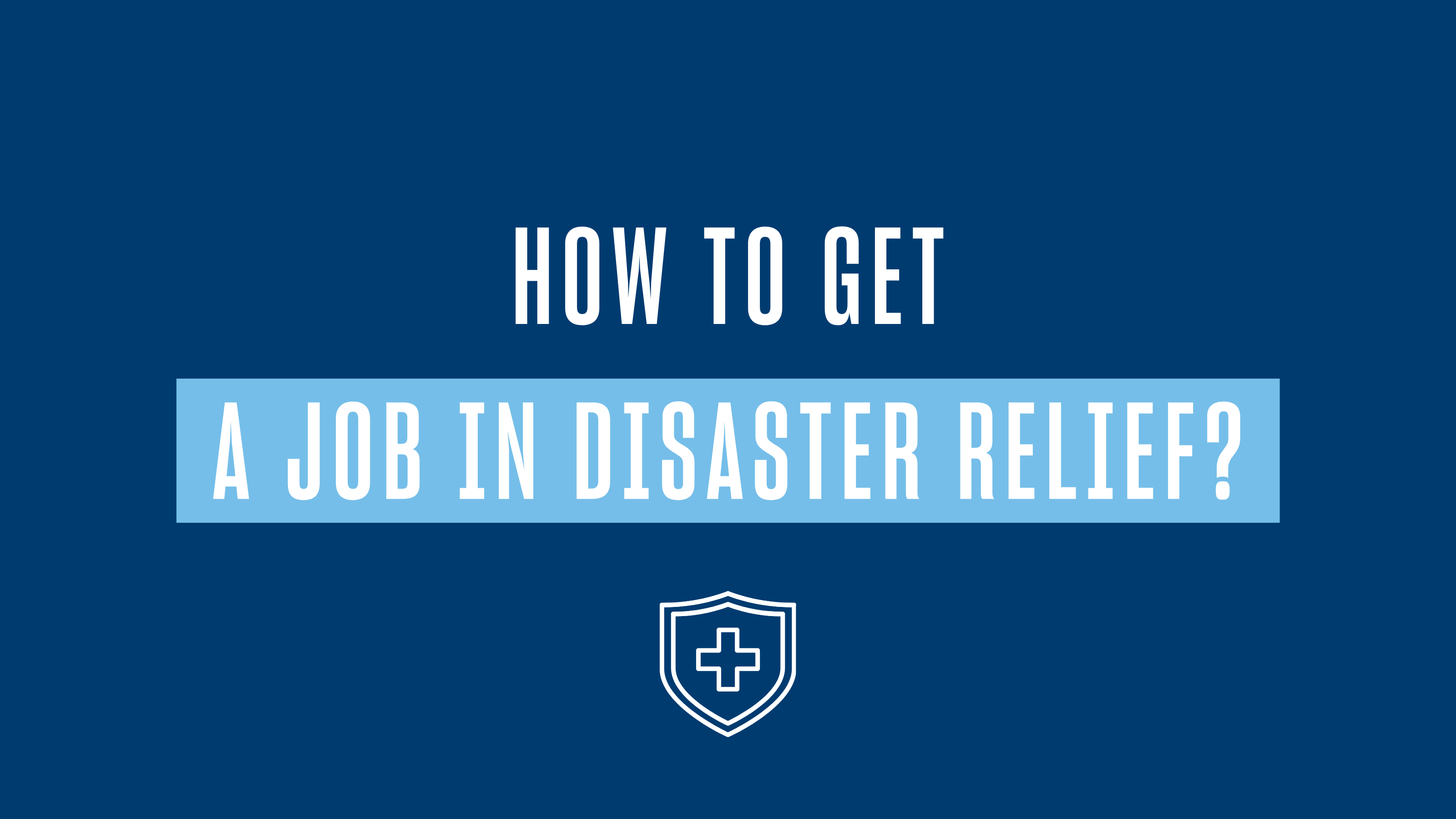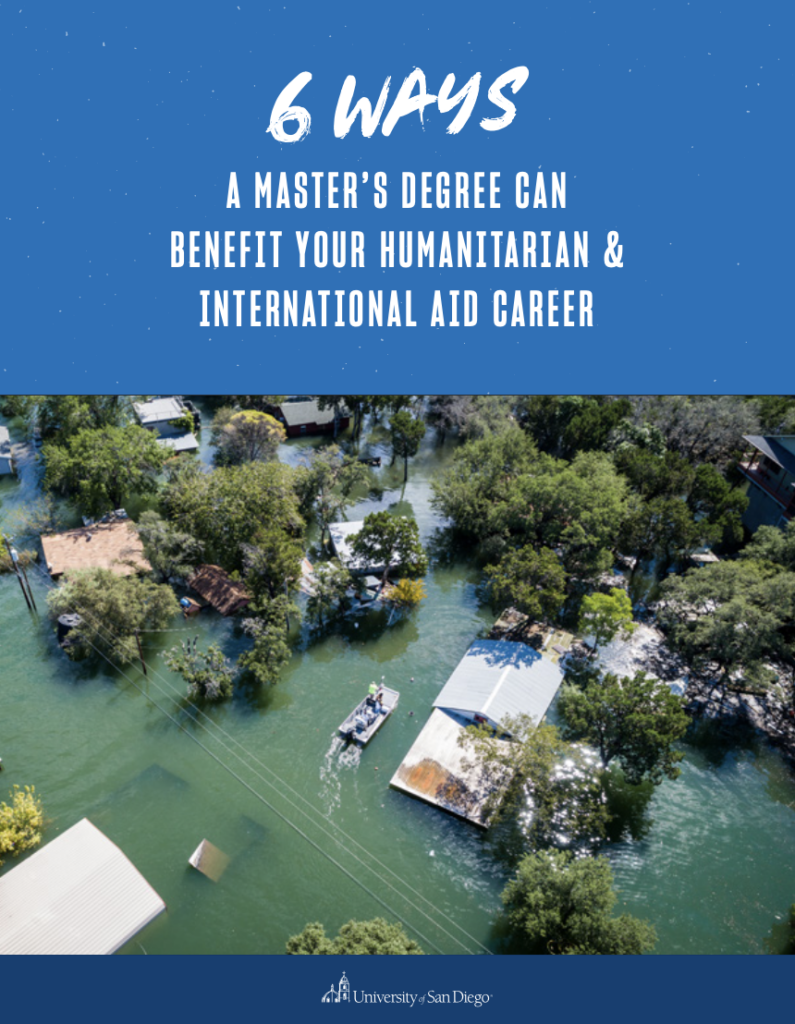In a world increasingly affected by climate change and threatened natural services, old and new threats to humanity converge: everything from earthquakes and droughts to epidemics, food shortages, wildfires, floods, and famines. The need for disaster relief is great — and growing.
This much-needed assistance, however, is only made possible by the skilled workers and volunteers who are ready to step up and take on such challenging yet rewarding work.
There is a wide variety of disaster relief roles that are essential in humanitarian work, which means you can explore positions that fit your interests, expertise, and career goals. This guide will explore many of these opportunities, including typical responsibilities, top careers, tips for obtaining a disaster relief job, salary expectations, and more.
What Does a Disaster Relief Worker Do?
In general, there are four phases of relief work: preparedness, response, recovery and mitigation. Responsibilities will depend on the specific position, but here are some common examples:
Preparedness
- Develop emergency response plans (including community consultations to inform their design)
- Conduct training exercises
- Develop emergency supply lists and corresponding stockpiles
Response
- Rapidly assess the needs of a disaster-affected population
- Direct disaster response efforts (this includes the delivery and sourcing of food assistance and medicine; shelter and housing provision; water and sanitation services; healthcare provisions; and family reunification)
- Communicate clearly with the public and affected community
- Negotiate for humanitarian access and security corridors
- Civil-military liaison
- Legal aid to asylum-seekers
- Refugee resettlement in host countries
- Animal rescue operations (including domestic animal and wildlife responses)
Recovery
- Assist in infrastructure rebuilding efforts such as power restoration, transportation, communication and other basic services
- Aid in rebuilding housing
- Restore other private assets, including office and industrial facilities and agricultural lands
- Restore damaged natural assets (e.g. forests, riparian or littoral wetlands, affected species populations)
Mitigation
- Evaluation of previous prevention, response, and recovery efforts to inform future initiatives
- Assessment of future hazard threats, population vulnerabilities, and coping mechanism weaknesses to inform preparedness strategies
- Infrastructure adaptation (e.g. roads and bridges; canals and locks; telephone and internet; berms, retaining walls, and storm surge barriers; etc.)
- Natural systems design (e.g. wetlands regeneration, planting for erosion control and wind breaks, controlled burn plans, etc.)
- Policy changes designed to enhance government and private sector disaster response (e.g. insurance sector reforms, coordination initiatives [e.g. between military and emergency management entities; local, national, and international organizations])
- Targeted public education campaigns
Top Careers in Disaster Relief and Emergency Management
There are many different positions within the disaster relief realm, which means you can explore opportunities depending on your interests and experience. Some of the most common include:
- Emergency Management Specialists/Directors
- General and Operations Staff/Managers
- Social and Community Services Staff/Managers
- Public Health Directors and Specialists/Directors
- Public Information Officers
- Mental Health Counselors
- Social Workers
- Community Health Workers
- Emergency Medical Technicians
- Disaster Recovery Specialists/Managers
- Public Health Nurses/Doctors
- Disaster Response Coordinators
- Interpreters
- Epidemiologists
- Evaluators
Steps to Become a Disaster Relief Worker
Since disaster relief encompasses a variety of opportunities, the steps for each particular career may vary. But here are some important considerations to keep in mind:
Gain volunteer experience
This is one of the most important ways to gain experience, especially if you are just starting out in the field. Keep these important tips in mind:
- Search for internships and volunteer opportunities on job sites specifically dedicated to humanitarian-related work, such as ReliefWeb, Devex, and Omprakash.
- Consult with broader volunteer-minded resources such as VolunteerMatch, Idealist, Engage, and JustServe for opportunities that may not self-identify as “humanitarian” per se.
- You can also look at specific humanitarian organizations to see if they offer internships or volunteer opportunities directly through their websites. Well-known organizations include Relief International,UNICEF, Médecins Sans Frontières (Doctors Without Borders), Care International, the International Committee of the Red Cross and Red Crescent (ICRC), national Red Cross organizations like the American Red Cross, Mercy Corps, International Medical Corps, Alight, Global Communities, and International Rescue Committee.
- On a local level, consider volunteering at a hospital or animal shelter, assisting in a school or community center, tutoring, mentoring, organizing a collection drive or working at a library or homeless shelter.
Invest in an undergraduate and/or graduate degree
Relevant undergraduate degrees include international affairs, political science, social justice, economics, anthropology, sustainability, humanitarianism, and other related areas.
Many humanitarian field positions require a master’s degree, which means that investing in your education will enable you to pursue more disaster relief opportunities. Plus, obtaining a relevant master’s degree will connect you with other humanitarians in the industry and offer valuable experience, knowledge and training.
Look for a program that uses a multidisciplinary approach to teach the following topics:
- Assessing humanitarian needs
- Managing complex global emergencies
- Aid delivery, management and logistics
- Emergency preparedness
- Humanitarian leadership
- Local ownership and stakeholder analysis
- Program evaluation
- Effective communication
Explore specialized education and training
Positions such as nurses, doctors, EMTs, social workers and mental health counselors will require specialized education and training.
- The Federal Emergency Management Agency (FEMA) lists a variety of training resources for first responders and emergency managers. These opportunities include training through the National Fire Academy, Center for Domestic Preparedness and the Emergency Management Institute.
- FEMA also provides training opportunities for individuals and communities such as You Are the Help Until Help Arrives and Organizations Preparing for Emergency Needs (OPEN).
- The American Red Cross offers disaster training for all its volunteers, which make up 90% of the disaster workforce. Certifications include: Certified Emergency Manager (International Association of Emergency Managers) and Emergency Medical Technician (EMT).
Skills Needed for Disaster Relief
Job-specific skills will depend on the specific position, but certain overarching attributes and characteristics are essential to success in disaster relief work. These include:
- Strong teamwork, communication and organizational skills
- An understanding of the international system
- An understanding of the political and economic context and implications of global issues like climate change, armed conflict and forced migration
- Ability to adapt to evolving situations and cope well with high levels of stress
- Ability to multitask
- Willingness to travel and often work long hours as needed (and, in many cases, less-than-ideal conditions)
- Sensitivity toward other cultures
- Ability to make difficult decisions with imperfect information under time constraints
- Critical thinking
- Decision-making
- Time management and organization
- Supervision
- Dedication
- Empathy
Some positions may also require (or prefer) fluency in a second language (or multiple languages). Spanish, Arabic and French are quite common in humanitarian work.
Educational Requirements
The educational requirements will depend entirely on the position. A bachelor’s degree is often sufficient for certain roles, but higher-level positions such as directors and managers will typically require an advanced education. Medical-related positions such as doctors, nurses, midwives and mental health counselors will require specialized training and additional education.
According to the U.S. Bureau of Labor Statistics: “Disaster relief workers may choose to complete formal programs in emergency or disaster management, especially at the bachelor’s- and master’s-degree levels. Other credentials, such as the Certified Emergency Manager and the Certified Business Continuity Professional designations, may be required or preferred for some jobs. Still other training options may be available either in person or online, such as free courses offered by FEMA.”
Disaster Relief Worker Salaries
Your salary will depend on a number of factors, including the position itself, company or organization, location and experience required.
Depending on the role, you may not be paying for your own lodging and sometimes even personal transportation, and that the cost of living in disaster-affected areas may deviate from other locations.
We’ve listed a sampling of salaries below, but please keep in mind that these numbers may fluctuate based on real-time data.
- Emergency Management Directors — $76,730
- Social Worker — $50,390
- EMTs and Paramedics — $36,930
- Health Education Specialists and Community Health Workers — $48,860
- Public Health Nurse — $66,799
- Disaster Recovery Manager — $83,256
- General and Operations Manager — $97,970
- Emergency Response Team Coordinator — $91,955
- Public Health Director — $75,017
- Fundraiser — $66,670
- Public Health Physician — $199,316
Additional Resources
For more information about disaster relief, please check out the following resources:
- FEMA
- American Red Cross
- Organizations Preparing for Emergency Needs (OPEN) — FEMA
- Emergency Preparedness and Response Training Resources — CDC
- Habitat for Humanity Disaster Response Programs
- Direct Relief
- Doctors Without Borders
- CARE International — Crisis Response
- International Rescue Committee
Elevate Your Disaster Relief Career With a Master’s Degree from USD
The 100% online University of San Diego Master of Science in Humanitarian Action provides an innovative, multidisciplinary curriculum taught by experienced, knowledgeable faculty. Position yourself for leadership and success in the humanitarian field with a master’s degree you can earn in just 20 months.
Connect with a USD enrollment advisor today for more information.



![Top 30 Humanitarian Careers [+ Salary Info]](https://onlinedegrees.sandiego.edu/wp-content/uploads/2022/12/masha_top-30-humanitarian-careers-1024x576.png)
![9 Tips for Becoming an International Aid Worker [+Salaries]](https://onlinedegrees.sandiego.edu/wp-content/uploads/2023/01/MASHA_blog_9tips-1024x576.png)
![How to Become a Humanitarian Coordinator [Career Guide] with heart in hands icon](https://onlinedegrees.sandiego.edu/wp-content/uploads/2023/09/MSHA_BLOG_HOW-TO-BECOME-HUMANITARIAN-1024x576.png)